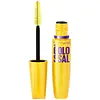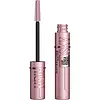What's inside
What's inside
 Key Ingredients
Key Ingredients

 Benefits
Benefits

 Concerns
Concerns

 Ingredients Side-by-side
Ingredients Side-by-side

Water
Skin ConditioningParaffin
PerfumingPotassium Cetyl Phosphate
EmulsifyingBeeswax
Emulsion StabilisingCopernicia Cerifera Wax
Acacia Senegal Gum
MaskingGlycerin
HumectantCetyl Alcohol
EmollientHydroxyethylcellulose
Emulsion StabilisingSodium Polymethacrylate
Emulsion StabilisingHydrogenated Jojoba Oil
AbrasiveHydrogenated Palm Oil
EmollientPhenethyl Alcohol
MaskingPhenoxyethanol
PreservativeSteareth-20
CleansingPEG/PPG-17/18 Dimethicone
EmulsifyingPolyquaternium-10
Silica
AbrasiveSoluble Collagen
HumectantSimethicone
EmollientPanthenol
Skin ConditioningDisodium EDTA
CI 77491
Cosmetic ColorantCI 77492
Cosmetic ColorantCI 77499
Cosmetic ColorantCI 77891
Cosmetic ColorantCI 77007
Cosmetic ColorantCI 77288
Cosmetic ColorantCI 77289
Cosmetic ColorantCI 77742
Cosmetic ColorantCI 77510
Cosmetic ColorantMica
Cosmetic ColorantWater, Paraffin, Potassium Cetyl Phosphate, Beeswax, Copernicia Cerifera Wax, Acacia Senegal Gum, Glycerin, Cetyl Alcohol, Hydroxyethylcellulose, Sodium Polymethacrylate, Hydrogenated Jojoba Oil, Hydrogenated Palm Oil, Phenethyl Alcohol, Phenoxyethanol, Steareth-20, PEG/PPG-17/18 Dimethicone, Polyquaternium-10, Silica, Soluble Collagen, Simethicone, Panthenol, Disodium EDTA, CI 77491, CI 77492, CI 77499, CI 77891, CI 77007, CI 77288, CI 77289, CI 77742, CI 77510, Mica
Water
Skin ConditioningPropylene Glycol
HumectantStyrene/Acrylates/Ammonium Methacrylate Copolymer
Polyurethane-35
Cera Alba
EmollientSynthetic Fluorphlogopite
Glyceryl Stearate
EmollientCetyl Alcohol
EmollientPEG-200 Glyceryl Stearate
Ethylenediamine/Stearyl Dimer Dilinoleate Copolymer
Skin ConditioningCopernicia Cerifera Cera
EmollientStearic Acid
CleansingPalmitic Acid
EmollientEthylene/Va Copolymer
Emulsion StabilisingAlcohol Denat.
AntimicrobialParaffin
PerfumingAminomethyl Propanediol
BufferingPhenoxyethanol
PreservativeCaprylyl Glycol
EmollientGlycerin
HumectantHydroxyethylcellulose
Emulsion StabilisingButylene Glycol
HumectantRayon
Xanthan Gum
EmulsifyingCaprylic/Capric Triglyceride
MaskingSodium Laureth Sulfate
CleansingDisodium EDTA
Myristic Acid
CleansingTetrasodium EDTA
Pentaerythrityl Tetra-Di-T-Butyl Hydroxyhydrocinnamate
AntioxidantPotassium Sorbate
PreservativeSilica
AbrasiveSoluble Collagen
HumectantBambusa Vulgaris Extract
Skin ConditioningTrisodium EDTA
CI 77491
Cosmetic ColorantCI 77492
Cosmetic ColorantCI 77499
Cosmetic ColorantCI 77007
Cosmetic ColorantMica
Cosmetic ColorantCI 77891
Cosmetic ColorantCI 75470
Cosmetic ColorantCI 77288
Cosmetic ColorantCI 77742
Cosmetic ColorantCI 77510
Cosmetic ColorantCeramide AP
Skin ConditioningWater, Propylene Glycol, Styrene/Acrylates/Ammonium Methacrylate Copolymer, Polyurethane-35, Cera Alba, Synthetic Fluorphlogopite, Glyceryl Stearate, Cetyl Alcohol, PEG-200 Glyceryl Stearate, Ethylenediamine/Stearyl Dimer Dilinoleate Copolymer, Copernicia Cerifera Cera, Stearic Acid, Palmitic Acid, Ethylene/Va Copolymer, Alcohol Denat., Paraffin, Aminomethyl Propanediol, Phenoxyethanol, Caprylyl Glycol, Glycerin, Hydroxyethylcellulose, Butylene Glycol, Rayon, Xanthan Gum, Caprylic/Capric Triglyceride, Sodium Laureth Sulfate, Disodium EDTA, Myristic Acid, Tetrasodium EDTA, Pentaerythrityl Tetra-Di-T-Butyl Hydroxyhydrocinnamate, Potassium Sorbate, Silica, Soluble Collagen, Bambusa Vulgaris Extract, Trisodium EDTA, CI 77491, CI 77492, CI 77499, CI 77007, Mica, CI 77891, CI 75470, CI 77288, CI 77742, CI 77510, Ceramide AP
 Reviews
Reviews

Ingredients Explained
These ingredients are found in both products.
Ingredients higher up in an ingredient list are typically present in a larger amount.
Cetyl Alcohol is a fatty alcohol. Fatty Alcohols are most often used as an emollient or to thicken a product.
Its main roles are:
Though it has "alcohol" in the name, it is not related to denatured alcohol or ethyl alcohol.
The FDA allows products labeled "alcohol-free" to have fatty alcohols.
Learn more about Cetyl AlcoholThis pigment is called Ultramarine blue lazurite. It gives a saturated blue color, but can be used to create other colors as well.
According to the manufacturer, it is usually made from kaolin, sodium sulfate, sodium carbonate, sulfur, and charcoal.
Ci 77288 is used to add green pigment to products.
Ci 77491 is also hydrated iron III oxide. It's sole purpose is to give a red/pink hue to products.
Iron III oxides are classified as inorganic chemicals for coloring.
Synthetically created Ci 77491 is considered safer than those naturally found. This is because the synthetically created version may contain less impurities. Iron oxides are generally non-toxic and non-allergenic.
Learn more about CI 77491Ci 77492 is also hydrated iron III oxide. It's sole purpose is to give a yellow hue to products.
Iron III oxides are classified as inorganic chemicals for coloring.
Synthetically created Ci 77492 is considered safer than those naturally found. This is because the synthetically created version may contain less impurities. Iron oxides are generally non-toxic and non-allergenic.
Learn more about CI 77492Ci 77499 is also hydrated iron III oxide. It is created from mixing red and black iron oxides. This helps give shades of darkness to a product.
Iron III oxides are classified as inorganic chemicals for coloring.
This ingredient is used to impart a blue color. It is not water-soluble.
It goes by two different names:
1. Ferric Ferrocyanide: a synthetic dark blue pigment
2. Ferric Ammonium Ferrocyanide: a synthetic blue pigment, also called Prussian blue
In the EU, both of these colors must be labeled as 'CI 77510'.
Learn more about CI 77510This ingredient is used to add a violet color to cosmetics.
It is created by reacting phosphoric acid, ammonium dihydrogen orthophosphate, and manganese dioxide.
Ci 77891 is a white pigment from Titanium dioxide. It is naturally found in minerals such as rutile and ilmenite.
It's main function is to add a white color to cosmetics. It can also be mixed with other colors to create different shades.
Ci 77891 is commonly found in sunscreens due to its ability to block UV rays.
Learn more about CI 77891Disodium EDTA plays a role in making products more stable by aiding other preservatives.
It is a chelating agent, meaning it neutralizes metal ions that may be found in a product.
Disodium EDTA is a salt of edetic acid and is found to be safe in cosmetic ingredients.
Learn more about Disodium EDTAGlycerin is already naturally found in your skin. It helps moisturize and protect your skin.
A study from 2016 found glycerin to be more effective as a humectant than AHAs and hyaluronic acid.
As a humectant, it helps the skin stay hydrated by pulling moisture to your skin. The low molecular weight of glycerin allows it to pull moisture into the deeper layers of your skin.
Hydrated skin improves your skin barrier; Your skin barrier helps protect against irritants and bacteria.
Glycerin has also been found to have antimicrobial and antiviral properties. Due to these properties, glycerin is often used in wound and burn treatments.
In cosmetics, glycerin is usually derived from plants such as soybean or palm. However, it can also be sourced from animals, such as tallow or animal fat.
This ingredient is organic, colorless, odorless, and non-toxic.
Glycerin is the name for this ingredient in American English. British English uses Glycerol/Glycerine.
Learn more about GlycerinHydroxyethylcellulose is used to improve the texture of products. It is created from a chemical reaction involving ethylene oxide and alkali-cellulose. Cellulose is a sugar found in plant cell walls and help give plants structure.
This ingredient helps stabilize products by preventing ingredients from separating. It can also help thicken the texture of a product.
This ingredient can also be found in pill medicines to help our bodies digest other ingredients.
Learn more about HydroxyethylcelluloseMica is a naturally occurring mineral used to add shimmer and color in cosmetics. It can also help improve the texture of a product or give it an opaque, white/silver color.
Serecite is the name for very fine but ragged grains of mica.
This ingredient is often coated with metal oxides like titanium dioxide. Trace amounts of heavy metals may be found in mica, but these metals are not harmful in our personal products.
Mica has been used since prehistoric times throughout the world. Ancient Egyptian, Indian, Greek, Roman, Aztec, and Chinese civilizations have used mica.
Learn more about MicaParaffin is a solid created from petroleum. The term 'paraffin' can also refer to either
petroleum jelly or mineral oil.
It has natural occlusive properties which can worsen oily skin. Due to its petrolatum base, this ingredient is not fungal-acne safe.
Phenoxyethanol is a preservative that has germicide, antimicrobial, and aromatic properties. Studies show that phenoxyethanol can prevent microbial growth. By itself, it has a scent that is similar to that of a rose.
It's often used in formulations along with Caprylyl Glycol to preserve the shelf life of products.
Silica, also known as silicon dioxide, is a naturally occurring mineral. It is used as a fine, spherical, and porous powder in cosmetics.
Though it has exfoliant properties, the function of silica varies depending on the product.
The unique structure of silica enhances the spreadability and adds smoothness, making it a great texture enhancer.
It is also used as an active carrier, emulsifier, and mattifier due to its ability to absorb excess oil.
In some products, tiny microneedles called spicules are made from silica or hydrolyzed sponge. When you rub them in, they lightly polish away dead skin layers and enhance the penetration of active ingredients.
Learn more about SilicaSoluble collagen comes from animals and fish. It has a large molecule size, meaning it doesn't get absorbed into skin.
Instead, it sits on top of skin as a humectant to improve skin hydration. It has incredible water-binding properties and creates a water barrier on skin that prevents evaporation.
This ingredient is incredibly gentle and often used to counter more irritating ingredients.
While our skin does have collagen, this ingredient is not used by the skin for anti-aging. Applying collagen topically has not been linked to helping with collagen loss in skin. All the benefits of soluble collagen are related to hydration.
Fun fact: The name "soluble collagen" refers to its ability to dissolve in water.
Learn more about Soluble CollagenWater. It's the most common cosmetic ingredient of all. You'll usually see it at the top of ingredient lists, meaning that it makes up the largest part of the product.
So why is it so popular? Water most often acts as a solvent - this means that it helps dissolve other ingredients into the formulation.
You'll also recognize water as that liquid we all need to stay alive. If you see this, drink a glass of water. Stay hydrated!
Learn more about Water